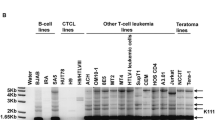Abstract.
Sixteen human endogenous retrovirus (HERV) sequences were detected within 656 kb of genomic sequence obtained from the alpha- and beta-block of the class I region of the major histocompatibility complex (MHC). The HERVs were identified and characterized as family members of HERV-16 (11 copies), HERV-L (1 copy), HERV-I (2 copies), HERV-K91 (1 copy), and HARLEQUIN (1 copy) by sequence comparison using CENSOR or Repeat Masker, BLAST searches, and dot plots. The 11 copies of HERV-16 arose as products of duplication of genomic segments containing HLA class I (HLAcI) and PERB11 (MIC) genes inter alia, whereas the other five HERVs arose after duplication probably as a consequence of single insertion events or translocations. HERV-L and HERV-I are located between the duplicated genes PERB11.2 (MICB) and PERB11.1 (MICA), and HLA-B and HLA-C, respectively, whereas HERV-K91 and HARLEQUIN are located telomeric of HLA-C. A highly fragmented copy of HERV-I was also found telomeric of PERB11.4. Structural analysis of open reading frames (ORFs) revealed the absence of intact coding sequence within the putative gag, pol, and env gene regions of all the HERVs with the exception of HERV-K91, which had two large ORFs within the region of the putative protease and pol genes. In addition, the 5′-LTR of HERV-L contained a 2.5-kb element that was AT-rich and large ORFs with putative amino acid sequences rich in tyrosines and isoleucines. HERV-I, HARLEQUIN, and at least four copies of HERV-16 appear to have been receptors for the insertion of other retrotransposons including Alu elements and fragments of L1 and THE1. Examination of flanking sequences suggests that HERV-I and HERV-L had occurred by insertion into ancient L1 fragments. This study has revealed that the alpha- and beta-block region within the MHC is rich in HERV sequences occurring at a much higher ratio (10 to 1) than normally observed in the human genome. These HERV sequences will therefore enhance further studies on disease associations and differences between human haplotypes and primates and their role in the evolution of class I genes in the MHC.
Similar content being viewed by others
Author information
Authors and Affiliations
Additional information
Received: 17 September 1998 / Accepted: 8 January 1999
Rights and permissions
About this article
Cite this article
Kulski, J., Gaudieri, S., Inoko, H. et al. Comparison Between Two Human Endogenous Retrovirus (HERV)-Rich Regions Within the Major Histocompatibility Complex. J Mol Evol 48, 675–683 (1999). https://doi.org/10.1007/PL00006511
Issue Date:
DOI: https://doi.org/10.1007/PL00006511




